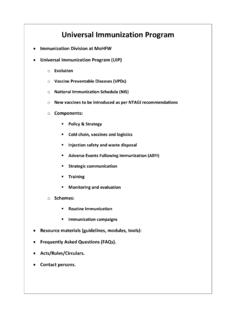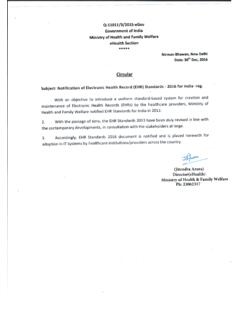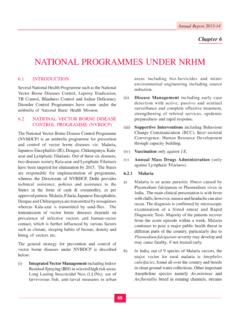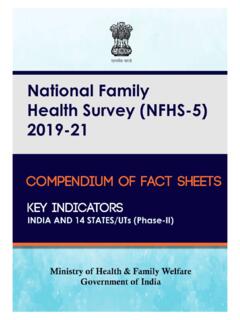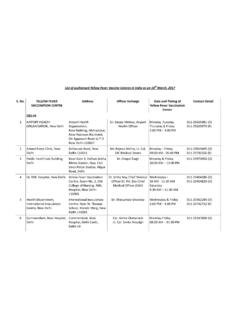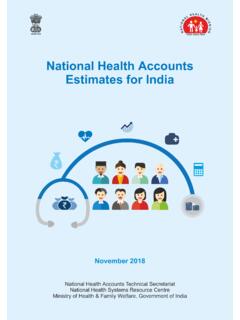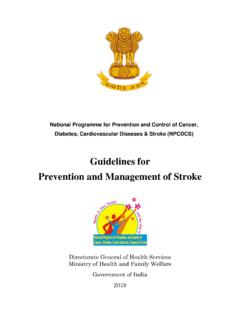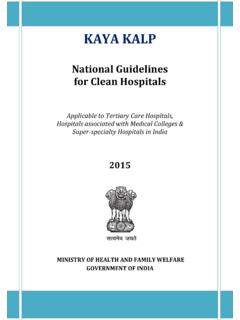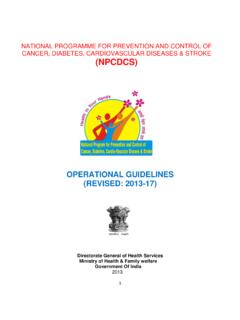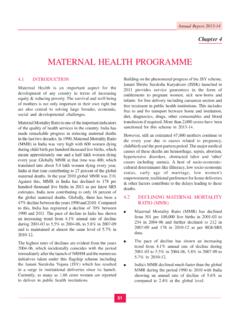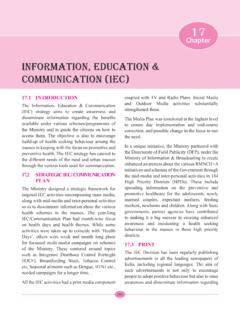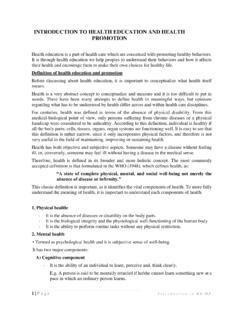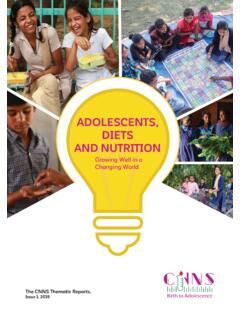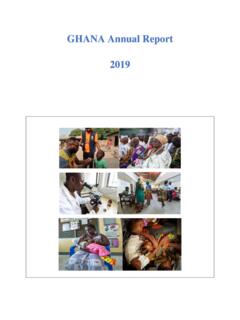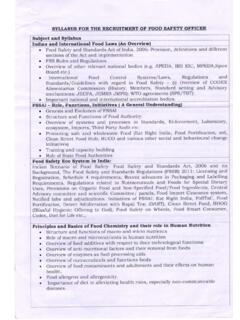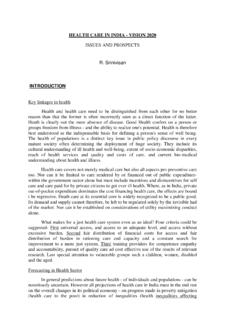Transcription of CANCER PREVENTION AND CONTROL IN INDIA
1 50 Years of CANCER CONTROL in India48 CANCER PREVENTION AND CONTROL IN INDIAC herian VargheseNon-communicable diseases including CANCER are emerging asmajor public health problems in INDIA . These diseases are lifestylerelated, have a long latent period and needs specialised infrastructureand human resource for treatment. INDIA still has a high burden ofpreventable communicable diseases and will offer competition for theresource risk factors of the major non-communicable diseases(Diabetes Mellitus, Cardiovascular Diseases, Diabetes, and many typesof CANCER ) are tobacco, dietary habits, inadequate physical activityand alcohol consumption. This offers the prospect for integratedprimary PREVENTION of the problemPopulation based CANCER registries within the National CANCER RegistryProgramme and outside the network has provided a picture of thecancer pattern in INDIA ( ).
2 There are areas, which are largelyun-represented, but the general pattern seems to hold on the CANCER registry data it is estimated that there willbe about 800,000 new cancers cases in INDIA every year. At anygiven point there is likely to be 3 times this load that about 240, sites associated with tobacco form 35 to 50% of allcancers in men and about 17% of cancers in women. These cancersare amenable to primary PREVENTION and can be controlled to a EpidemiologyCancer is group of diseases with similar characteristics. CANCER canoccur in all living cells in the body and different CANCER types havedifferent natural history. Epidemiological studies have shown that 70-90% of all cancers are environmental.
3 Lifestyle related factors are themost important and preventable among the environmental Years of CANCER CONTROL in India4949 Tobacco consumption either as chewing tobacco or smoking tobaccowill account for 50% of all cancers in men. Dietary practices,reproductive and sexual practices etc will account for 20-30% ofcancers. Appropriate changes in lifestyle can reduce the mortality andmorbidity from a good proportion of CANCER , Diabetes Mellitus andCardiovascular is the most important identified cause of CANCER and isresponsible for about 40 to 50% of cancers in men and about 20% Leading CANCER sites in Population Based Registries in INDIA 1995-9650 Years of CANCER CONTROL in India50cancers in women.
4 INDIA has the added burden of tobacco chewingwhich is more prevalent than smoking in many areas. Tobacco chewinghas resulted in a huge burden of Oral cancers and oral precancerousconditions. There are various other forms of tobacco use peculiar tocertain geographic regions of INDIA and these need special causes of CANCER in was estimated by Doll and Peto in1981. Tobacco was found to be responsible for 25-40% of cancersand diet for 10-70% of cancers. In INDIA dietary habits may beresponsible for about 10 to 20% of cancers. Dietary factors mayenhance the role of other risk factors. Most of the cancers have somerelationships with diet. Predominant among them are cancers of theupper aero digestive tract (mouth, throat, oesophagus and lungs),stomach, large intestine, and breast CANCER in role of diet takes special importance in countries like INDIA ,which are fast moving towards industrialization and had a predominantly plant based diet and with the advent ofwestern life style we are moving towards a diet rich in animal coupled with other habits like smoking and alcohol will lead toincrease in the chronic disease burden especially CANCER andcardiovascular diseases.
5 Prompt action has to be taken to spreadthe message of healthy life style and dietary of the head and neckThe main risk factors for these cancers are tobacco and alcohol. Adiet rich in green and yellow vegetables has been shown to offerprotection against oral CANCER . Avoidance of tobacco and alcohol isthe most important preventive action against mouth, throat and lungcancers. CANCER of the Oral cavity can be detected early and everyopportunity in which a health care person interacts with a tobaccohabituee should be exploited to detect pre cancerous conditions orcancers of the oral of the stomachJapanese had the highest rate of stomach CANCER of the world andthe rates in Japanese migrants have dropped to very low levels as50 Years of CANCER CONTROL in India5151that of Americans when they migrated to the United States.
6 This isclear evidence of the dietary pattern and risk of stomach CANCER . Theadvent of refrigeration has dramatically reduced stomach cancerincidence as it has revolutionised food preservation. Consumption oflarge amounts of red chillies, food at very high temperatures and alcoholconsumption are the main risk factors for stomach CANCER in of a tobacco extract 'Tuibur' has been linked to the highrates of Stomach CANCER in Mizoram. Primary PREVENTION is the beststrategy for PREVENTION of stomach of the large intestineHeavy consumption of red meat can lead to risk of colon meat such as that of poultry do not have this risk. There is aninternational correlation in between the occurrence of large bowelcancer and consumption of red meat.
7 In South INDIA there is a trendtowards increasing consumption of red meat and this can lead toincreased risk for large bowel of the breast in womenBreast CANCER is emerging as the leading CANCER in women. A largenumber of factors are identified as risk factors for breast CANCER . Lateage at first pregnancy (greater than 30 years), single child, late ageat menopause etc are some of them. A high fat diet is alsoidentified as a risk factor. Physical activity is found to be protectivefor breast CANCER . The sudden changes towards affluent life styleshave reduced the physical activities to a minimum and increased theconsumption of diets rich in fat. High fat diets during the pubertal ageand obesity in the post menopausal age are risk factors for breast self examination by women themselves is a verygood way of detecting breast CANCER in early stages.
8 Detecting acancer when it is in the very early stage can improve the cure ratefrom breast of the uterine cervixCancer of the uterine cervix is still the most common CANCER amongwomen in INDIA . Improvements in living standards and access to health50 Years of CANCER CONTROL in India52care have reduced the rate of occurrence of cervical CANCER in certainStates like Kerla. However the changing sexual behaviour in youngadults might lead to another wave of cervical cancers. Early age atfirst intercourse, multiple sexual partners, poor sexual hygiene,repeated child birth etc are some of the reproductive risk factors forcervical CANCER . Improvements in the living standards of women haveresulted in a reduction in the incidence of cervical CANCER .
9 Regularcervical cytology examination (papsmear) by all women who haveinitiated sexual activity can prevent the occurrence of cervical has been successfully achieved in many European there are many limitations for cytology based cervical cancerscreening in INDIA . The States in INDIA are in various levels of healthcare delivery and health infrastructure and it is possible that thereare certain areas in which screening programmes could be system for screening, with facilities for call back and proper referralare very important, irrespective of the screening PREVENTION and treatment strategies for IndiaIndia is the one of the few developing countries that has formulated aNational CANCER CONTROL Programme. The programme envisages controlof tobacco related cancers; early diagnosis and treatment of uterinecervical CANCER ; and distribution of therapy services, pain relief andpalliative care through augmentation of health infrastructure.
10 Suggestedsurrogate outcome measures include change in tobacco use,'Knowledge, Attitude, Practice'(KAP) pattern, compliance to screeningprogrammes, changes in referral practices and shift in PREVENTION and screening programsPrimary PREVENTION is the most cost effective PREVENTION program asit aims to reduce the incidence of CANCER by risk factor percent of all cancers in males are tobacco related and a largeproportion of them can be prevented by anti-tobacco programs. Thishas to be publicised more widely. Teen age students need to betargeted as most of them pick up habits at this time. The schoolcurricula should involve messages for a healthy life style and warnabout the harmful effects of tobacco and alcohol.
